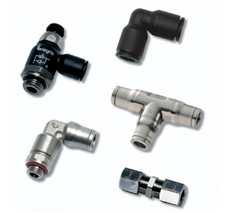

In a wide range of industrial and engineering applications, pneumatic fittings serve as the backbone of the smooth operation of machinery and the safe transport of various gases. Pneumatic fittings have carved a niche for their efficiency in air systems, widely used for their quick connect and disconnect capabilities and expansive range of materials and adaptability.
The versatility and quality of these important components raise an interesting question: Can pneumatic fittings be used for water applications? On the surface level, this seems possible. However, the question requires a deeper examination that includes assessing material compatibility, pressure handling, temperature ranges, and sealing effectiveness to make sure that components typically used for compressed air and other gases can meet the demands of water. If you are asking yourself can I use pneumatic fittings for water, then you need to be able to address these concerns. Fortunately, we are here with our guide on using pneumatic fittings for water applications, so you can determine if pneumatic fittings are right for your application.
Pneumatic fittings are integral components within pneumatic systems, designed to connect sections of pipe, tube, and hose seamlessly and maintain pressure. These fittings ensure the controlled flow and direction of air, which is vital for the operation of pneumatic tools, cylinders, and air preparation units across a multitude of industries.
These small but mighty fittings are available in a diverse array of shapes, sizes, and materials, including plastic, brass, and stainless steel. Their functionality goes beyond making connections too, they are crucial for maintaining system integrity, preventing leaks, and facilitating efficient air distribution. Whether in manufacturing, automotive, or construction, the reliability and precision of these fittings are unmatched and vitally important for the smooth running of daily operations in industries across the world.
Pneumatic fittings are ubiquitous in systems that require the precise control of air to power a vast array of machinery and tools. A pneumatic system, whether it powers assembly lines or operates automated machinery, relies on these fittings for its efficiency and consistency. They are particularly important in sectors such as manufacturing, where air-powered tools require quick and reliable connections, and in automotive applications, where they ensure the smooth operation of pneumatic brake systems.
Construction industries benefit greatly from the use of pneumatic fittings in air-powered nail guns and jackhammers, illustrating the fittings’ versatility and essential role in productivity and operational safety across a diverse range of applications.
Pneumatic fittings have a lot of potential for use in water applications. Deciding if the solution is right for your demands involves a nuanced understanding of several critical factors:
Using pneumatic fittings in water applications comes with its own set of advantages and limitations that need consideration. The ease of installation and the broad availability of these fittings make a compelling case for their use. Pneumatic fittings are designed for quick connection and disconnection, making them highly convenient for systems that require regular maintenance or modifications. This feature can significantly reduce downtime and labour costs. The wide range of materials, sizes, and designs available allows for flexibility in system design and the ability to meet the requirements of water applications.
The potential limitations, however, must also be carefully weighed. One of the primary concerns is the compatibility of standard pneumatic fittings with the specific demands of water systems, especially regarding pressure handling and long-term exposure to water. While many pneumatic fittings are designed to withstand the pressures common in compressed air systems, water systems may present higher pressures or different pressure dynamics that could challenge the fitting’s integrity. The sealing mechanisms that work flawlessly in air systems may not offer the same level of performance in water, leading to leaks and system failures if not properly addressed. These considerations highlight the importance of thorough evaluation and testing when adapting pneumatic fittings for use in water applications, ensuring that the advantages are leveraged without compromising the system’s reliability and safety.
While pneumatic fittings are traditionally earmarked for air systems, their potential utility in water applications cannot be overlooked. If you are contemplating the integration of pneumatic fittings into your water systems, we encourage you to delve into our extensive range of products designed to meet diverse application needs. Our team is on hand to provide expert advice and support, ensuring you select the most suitable fittings for your specific requirements. Discover the perfect solution for your needs and contact us today.